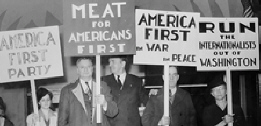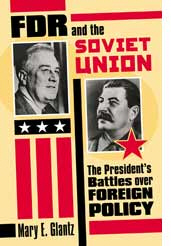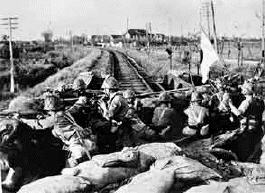Multiple Choice
Identify the
choice that best completes the statement or answers the question.
|
|
|
United States Responds Cautiously
As disturbing as these events in Europe and Asia
were to Americans, most believed that the United States should not get involved . In 1928, the United
States had joined 61 other nations in signing the Kellogg-Briand Pact, in which they pledged never
to make war again. But this agreement still permitted defensive war and did not provide for using
economic or military force against nations that broke the pact. |
 | | |
CLINGING TO ISOLATIONISM
In the early 1930s, a flood of books argued that the
United States had been dragged into World War I by greedy bankers and arms dealers. Public outrage
led to the creation of a congressional committee, chaired by North Dakota senator Gerald Nye,
that held hearings on these charges. The Nye committee fueled the controversy by documenting the
large profits that banks and manufacturers made during the war.
The furor over these
"merchants of death" made Americans more determined than ever to avoid war. A poll taken in
1937 revealed that fully 70 percent of Americans believed that the United States should not have
entered World War I. Anti war feeling was so strong that the Girl Scouts of America changed the color
of its uniforms from khaki to green to appear less militaristic. Across the country, college students
staged antiwar rallies with banners proclaiming "Scholarships, not battleships."
 |
Americans' growing isolationism
eventually had an impact on President Roosevelt's foreign policy. When he had first taken office
in 1933, Roosevelt had felt comfortable reaching out to the world in several ways. He officially
recognized the Soviet Union in 1933 and agreed to exchange ambassadors with Moscow. He continued the
policy of nonintervention in Latin America, begun by Presidents Coolidge and Hoover, with his Good
Neighbor policy and withdrew armed forces stationed there. In 1934, Roosevelt pushed the Reciprocal
Trade Agreement Act through Congress . This act lowered trade barriers by giving the president the
power to make trade agreements with other nations and was aimed at reducing tariffs by as much as 50
percent.
| | |
Beginning in 1935,
however, Congress passed a series
of Neutrality Acts in an effort to keep the United States out of future wars. The first two acts
outlawed arms sales or loans to nations at war. The third act was passed in response to fighting that
broke out in Spain in 1936, between the troops of the Fascist general Francisco Franco and forces
loyal to the country's elected government. This act extended the ban on arms sales and loans
to nations undergoing civil wars.
|
|
|
1.
|
Which statement is true about
the United States in the 1930’s
a. | America was anxious to get involved
in Europe so it could show American superiority | c. | America wanted to stay out of the wars in Europe and
Asia | b. | America wanted to get involved in Europe and Asia to profit financially from
the wars | d. | Americans did not have any opinion
about Japanese and German aggression |
|
|
|
2.
|
What did President Roosevelt do
in regards to the Soviet Union?
a. | he did
nothing | c. | he condemned the
atrocities of Joseph Stalin | b. | he offered diplomatic recognition | d. | he condemned the dictatorship of Stalin over the Russian
people |
|
|
|
3.
|
Who did the Nye committee label
as the "merchants of death".
a. | the Fascists in Italy and
Germany | c. | the Japanese
because of their attacks on china | b. | the bankers and industrialists who made profits from World War
I | d. | those who favored the death
penalty |
|
|
|
4.
|
What was the purpose of the
Neutrality Acts passed by Congress in 1935
a. | keep the U.S. out of future
wars | c. | condemn Germany and
Japan | b. | force neutrality on Mexico and Latin America | d. | keep the U.S. out of the League of
Nations |
|
|
|
NEUTRALITY BREAKS
DOWN
Despite congressional efforts to legislate neutrality,
many Americans found it difficult not to take sides in the Spanish Civil War. When Hitler and
Mussolini came to Franco's aid early in the war, some 3,000 volunteers from the United States
responded by forming the Abraham
Lincoln Brigade and traveling to Spain to fight Franco. 'We knew, we just knew,"
recalled Martha Gellhorn, "that Spain was the place to stop fascism ." Among the volunteers
were African Americans still bitter about Mussolini's invasion of Ethiopia the year
before.
Such limited aid was not sufficient to stop the spread of fascism, however. Hitler and
Mussolini, who saw the conflict as a testing ground for their military power, supported Franco with
troops, weapons, tanks, and fighter planes. The Western democracies, fearful of triggering a larger
war, sent only food and clothing to the anti- Fascist forces . In early 1939, after a loss of 600,000
lives and at a cost of more than $15 billion, the resistance to Franco had collapsed. Europe now had
yet another totalitarian government.

Japan attacks
Mancuria, China | Roosevelt himself found it impossible to remain neutral when Japan launched a
new attack on China in July of 1937. Since Japan had not formally declared war against China, the
president refused to enforce the Neutrality Acts . The United States continued sending arms and
supplies to China.
A few months later, Roosevelt spoke out strongly against isolationism in a
speech delivered in Chicago. He called on peace-loving nations to "quarantine," or isolate,
aggressor nations in order to stop the spread o of war.
| | |
At last Roosevelt seemed ready to take a stand against aggression-that is,
until isolationist newspapers exploded in protest and letters flooded the White House accusing the
president of leading the nation into war. Roosevelt backed off. For the moment the conflicts remained
"over there ."
|
|
|
5.
|
What was the purpose of the
Abraham Lincoln Brigade.
a. | to help the Communist anti-Soviet
forces in Russia | c. | to aid the
civil-rights movement in Spain | b. | to help the Communist anti-Franco forces in
Spain | d. | to aid the civil-rights movement in
Russia |
|
|
|
6.
|
What did Roosevelt do in
response to the Japanese attack on Manchuria, China?
a. | ignored
it | c. | tried to justify
it | b. | sent aid to
China | d. | blamed it on the
Republicans |
|
|
|
7.
|
Which statement is
true.
a. | Roosevelt saw the need for U.S.
intervention in foreign affairs but the people remained isolationist. | c. | Roosevelt saw the need for U.S. intervention in foreign
affairs and the people agreed with him | b. | Roosevelt did not see the need for U.S. intervention in foreign affairs but
the people did. | d. | Roosevelt did not see the need for
U.S. intervention in foreign affairs and the people
agreed |
|
|
|
8.
|
What did Hitler and Mussolini do about the civil war in Spain between the governemnt and
Franco?
a. | sent military help to
Franco | c. | tried to remain
neutral | b. | sent military help to the Spanish government | d. | declared war on Spain |
|
|
|
|
|
|
9.
|
General Franco became the
dictator of _____
a. | Russia | c. | Spain | b. | Germany | d. | Italy |
|
|
|
10.
|
Who became the Fascist dictator
of Italy?
a. | Hitler | c. | Franco | b. | Mussolini | d. | Stalin |
|